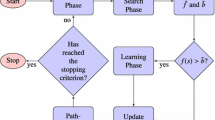Abstract
We propose a new metaheuristic, FRACTOP, for global optimization. FRACTOP is based on the geometric partitioning of the feasible region so that search metaheuristics such as Simulated Annealing (SA), or Genetic Algorithms (GA) which are activated in smaller subregions, have increased reliability in locating the global optimum. FRACTOP is able to incorporate any search heuristic devised for global optimization. The main contribution of FRACTOP is that it provides an intelligent guidance (through fuzzy measures) in locating the subregion containing the global optimum solution for the search heuristics imbedded in it. By executing the search in nonoverlapping subregions, FRACTOP eliminates the repetitive visits of the search heuristics to the same local area and furthermore, it becomes amenable for parallel processing. As FRACTOP conducts the search deeper into smaller subregions, many unpromising subregions are discarded from the feasible region. Thus, the initial feasible region gains a fractal structure with many space gaps which economizes on computation time. Computational experiments with FRACTOP indicate that the metaheuristic improves significantly the results obtained by random search (RS), SA and GA.
Similar content being viewed by others
References
Androulakis, G.S. and Vrahatis, M.N. (1996), OPTAC: a portable software package for analyzing and comparing optimization methods by visualization, Journal of Computational and Applied Mathematics 72: 41-62.
Armijo, L. (1966), Minimization of functions having Lipschitz continuous first partial derivatives, Pacific J. of Mathematics 16: 1-3.
Beveridge, G. and Schechter, R. (1970), Optimization: Theory and Practice, Mc-Graw Hill, New York.
Botsaris, C.A. (1978), A curvilinear optimization method based upon iterative estimation of the eigensystem of the hessian matrix, J. of Mathematical Analysis and Applications 63: 396-411.
Bozyel, M.A. and Özdamar, L. (1997), A heuristic approach to the capacitated lot sizing and scheduling problem (with parallel facilities), Working Paper, Istanbul Kültür University, Dept. of Computer Engineering, Istanbul.
Caprani, O., Gothaab, B. and Madsen, K. (1993), Use of real-valued local minimum in parallel interval global optimization, Interval Computations, 3: 71-82.
Csendes, T. and Pinter, J. (1993), The impact of accelerating tools on the interval subdivision algorithm for global optimization, European Journal of Operations Research 65, 314-320.
Davis, L. (ed.) (1987), Genetic Algorithms and Simulated Annealing, London, Pitman.
Fletcher, R. and Powell, M. (1963), A rapidly convergent descent method for minimization, Computer Journal 6: 163-168.
Fletcher, R. and Reeves, C. (1964), Function minimization by conjugate gradients, Computer Journal 7: 149-154.
Gill, P. and Murray, W. (1972), Quasi-Newton methods for unconstrained optimization, J. Institute of Mathematics and its Applications, 9: 91-108.
Glover, F. (1989), Tabu search-Part I, ORSA Journal of Computing 1: 190-206.
Goldberg, D. (1989), Genetic Algorithms in Search, Optimization and Machine Learning, Addison-Wesley.
Kan, A.H.G. and Timmer, G.T. (1984), Stochastic methods for global optimization, American J. of Mathematical Management Science 4: 7-40.
Kearfott, B., An efficient degree-computation method for a generalized method of bisection, Numerische Mathematics 32: 109-127.
Kirkpatrick, A., Gelatt, Jr., C.D. and Vechi, M.P. (1983), Optimization by simulated annealing, Science 220: 671-680.
Klir, G. and Folger, T. (1988), Fuzzy Sets Uncertainty and Information, Prentice Hall, Englewood Cliffs, N.J.
Michalewicz, Z. (1994), Genetic Algorithms + Data Structures = Evolution Programs, Springer Verlag, Berlin.
More, B.J., Garbow, B.S. and Hillstrom, K.E. (1981), Testing unconstrained optimization, ACM Trans. Math. Software 7: 17-41.
Özdamar, L. (1998), A genetic algorithm approach for the multi-mode resource-constrained project scheduling problem under general resource categories, to appear in IEEE Trans. On Systems, Man and Cybernetics.
Özdamar, L. and Birbil, ¸ S.I. (1998), A hybrid genetic algorithm for the capacitated lot sizing and loading problem, to appear in European Journal of Operations Research.
Özdamar, L. and Bozyel, M.A. (1998), Simultaneous lot sizing and loading of product families on parallel facilities of different classes, Int. J. Production Research, 36, 1305-1324.
Pal, N.R. and Bezdek, J.C. (1994), Measuring fuzzy uncertainty, IEEE Transactions on Fuzzy Systems 2, 107-118.
Pal, N.R., Bezdek, J.C. and Hemasinha, R. (1992), Uncertainty measures for evidential reasoning I: A review, Int. J. of Approximate Reasoning 7: 165-183.
Pal, N.R., Bezdek, J.C. and Hemasinha, R. (1993), Uncertainty measures for evidential reasoning II: A review Int. J. of Approximate Reasoning, 8, 1-16.
Press, W.H., Teukolsky, S.A., Vetterling, W.T. and Flannery, B.P. (1992), Numerical Recipes, The Art of Scientific Computing. Cambridge University Press, New York.
Ross, T.J. (1995), Fuzzy Logic with Engineering Applications, Mc-Graw Hill.
Schaffer, J.D. (1989), A study of control parameters affecting online performance of genetic algorithms for function optimization, Proc. of the Third Int. Con. on Genetic Algorithms 51-60.
Srinivas, M. and Patnaik, L.M. (1994), Adaptive probabilities of crossover and mutation in genetic algorithms, IEEE Transactions on Systems, Man and Cybernetics 24: 656-667.
Stenger, F. (1975), Computing the topological degree of a mapping in Rn, Numerische Mathematics 25: 23-38.
Tempelmeier, H. and Derstroff, M. (1996), A Lagrangean based heuristic for dynamic multi item multi level constrained lot sizing with setup times, Management Science 42: 738-757.
Törn, A. and Viitanen, S. (1994), Topographical global optimization using pre-sampled points, Journal of Global Optimization 5: 267-276.
Vrahatis, M.N. (1988), Solving systems of nonlinear equations using the nonzero value of the topological degree, ACM Trans. Math. Software 14: 312-329.
Yager, R. (1983), Entropy and specificity in a mathematical theory of evidence, Int. J. of General Systems 9: 149-260.
Zimmermann, H. (1991), Fuzzy Set Theory and Applications, Kluwer Academic Publishers, Dordrecht, The Netherlands.
Author information
Authors and Affiliations
Rights and permissions
About this article
Cite this article
Demirhan, M., Özdamar, L., Helvacıoğlu, L. et al. FRACTOP: A Geometric Partitioning Metaheuristic for Global Optimization. Journal of Global Optimization 14, 415–436 (1999). https://doi.org/10.1023/A:1008384329041
Issue Date:
DOI: https://doi.org/10.1023/A:1008384329041




